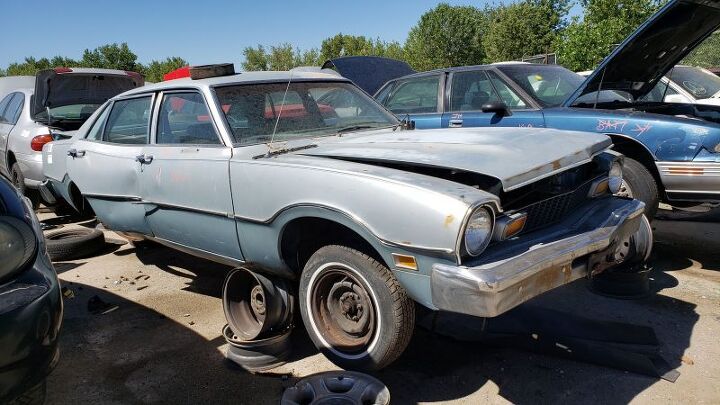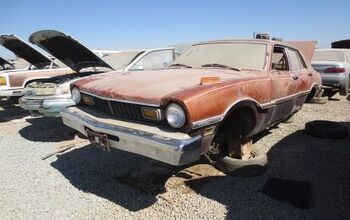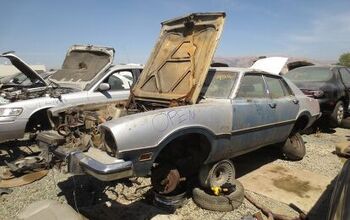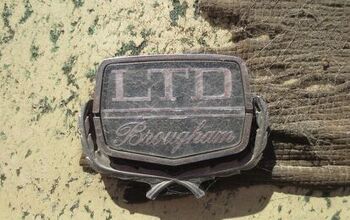Junkyard Find: 1976 Ford Maverick Sedan

Ford squeezed an amazing amount of value out of the 1960 Falcon‘s chassis design, with everything from the 1964-1973 Mustang to the 1980 Granada rolling Falcon-style. The Falcon itself got replaced here by the Maverick starting in 1970 (with one year of overlap when both were available), but the Maverick still had the 1960 Falcon’s bones under its skin. Millions of Mavericks (and near-identical Mercury Comets) were sold here during the 1970-1977 period, and nearly all of these affordable commutemobiles got crushed decades ago. Still, I run across the occasional Maverick/ Comet during my junkyard journeys, and I found this optioned-up ’76 in a Denver-area yard last summer.
I went to high school during the early 1980s, and the Maverick was one of the most likely cars to be handed down by relatives to my peers back then. No California teenager felt cool driving a stock Maverick (or Comet) during that era, though it could have been worse— you could have been stuck with a Pinto or Vega. I bypassed those image problems by dropping 50 bones on a hooptie 1969 Toyota Corona sedan in not-so-edgy beige and never looked back.
This car was on the semi-hip side, in fact, since it has a V8 engine. If we’re looking at the original engine— nowhere near a certainty, but possible— then this is a 302-cubic-inch ( 5.0-liter) Winsdor rated at 136 horsepower. Most Mavericks got the straight-six engine because if you could afford the $154 extra for the V8 (about $730 today), you probably felt rich enough to move up to a new Granada or even a Torino.
Of course, once you popped your clutch for that extra dough for the engine, why not continue shaking bills out of your wallet and get rid of the clutch in your new car? The three-speed automatic was a $245 option on this car (about $1,160 now), and this car has it. Otherwise, the base transmission for the ’76 Maverick was the three-on-the-tree manual (which disappeared from North American Ford cars after 1977 and from all new cars sold here after 1979).
I’m not sure what this cloth/vinyl bench-seat upholstery was called by Dearborn in 1976, but it’s a step up from the slippery all-vinyl base interior.
This aftermarket Panasonic AM/FM radio managed to avoid being stolen during this car’s career, which is something of an accomplishment.
These simple taillights were quite popular on kit cars during the 1970s, along with the round lights from Opel Mantas.
Cheaper than a new Volaré and with most of the same features!
For links to 2,100+ additional Junkyard Finds, Junkyard Gems, and Junkyard Treasures, visit the Junkyard Home of the Murilee Martin Lifestyle Brand™.

Murilee Martin is the pen name of Phil Greden, a writer who has lived in Minnesota, California, Georgia and (now) Colorado. He has toiled at copywriting, technical writing, junkmail writing, fiction writing and now automotive writing. He has owned many terrible vehicles and some good ones. He spends a great deal of time in self-service junkyards. These days, he writes for publications including Autoweek, Autoblog, Hagerty, The Truth About Cars and Capital One.
More by Murilee Martin
Latest Car Reviews
Read moreLatest Product Reviews
Read moreRecent Comments
- Probert They already have hybrids, but these won't ever be them as they are built on the modular E-GMP skateboard.
- Justin You guys still looking for that sportbak? I just saw one on the Facebook marketplace in Arizona
- 28-Cars-Later I cannot remember what happens now, but there are whiteblocks in this period which develop a "tick" like sound which indicates they are toast (maybe head gasket?). Ten or so years ago I looked at an '03 or '04 S60 (I forget why) and I brought my Volvo indy along to tell me if it was worth my time - it ticked and that's when I learned this. This XC90 is probably worth about $300 as it sits, not kidding, and it will cost you conservatively $2500 for an engine swap (all the ones I see on car-part.com have north of 130K miles starting at $1,100 and that's not including freight to a shop, shop labor, other internals to do such as timing belt while engine out etc).
- 28-Cars-Later Ford reported it lost $132,000 for each of its 10,000 electric vehicles sold in the first quarter of 2024, according to CNN. The sales were down 20 percent from the first quarter of 2023 and would “drag down earnings for the company overall.”The losses include “hundreds of millions being spent on research and development of the next generation of EVs for Ford. Those investments are years away from paying off.” [if they ever are recouped] Ford is the only major carmaker breaking out EV numbers by themselves. But other marques likely suffer similar losses. https://www.zerohedge.com/political/fords-120000-loss-vehicle-shows-california-ev-goals-are-impossible Given these facts, how did Tesla ever produce anything in volume let alone profit?
- AZFelix Let's forego all of this dilly-dallying with autonomous cars and cut right to the chase and the only real solution.


















































Comments
Join the conversation
Remember some of my senior mechanical engineering class going out to the Ford dealer in '69 to see a 428 Mustang drag car from the USA. While we waited to see that Mustang, a new green Maverick caught our attention. It was a three on the tree, and the standard of welding on the shift shaft linkage from the wheel to some other piece underhood was a joke. Weld spatter everywhere and who knows if the two pieces were actually united. Looked like a high school industial arts class had been let loose for practise. Wasn't worth two grand plus as it sat. Just horrible quality. I always remembered that when ten years or so later my dear mother used to call me up to come over and start her best friend's Maverick. Just opening the hood for the first time was an eye-opener in what total corrosion looked like. To me the thing was unsafe, the inner fenders that supported the spring/shock units peppered with holes. But those two late middle-aged dears always wanted to go shopping, no excuses, so wiping off the dewy distributor cap and leads seemed to work most days. After which the mobile collection of iron oxide could trundle off to the malls. I learned not to worry about it. How it passed the annual provincial inspection I'll never know.
Dad had a '74 Comet with the 302 V8. This is the year of "interlock" which failed every time. My responsibility was to press the reset button under the hood with each trip. The engine hissed, hesitated, stalled, surged, etc. Not till fully warmed would the engine behave. Fuel mileage was 12 to 15 on the highway at best. Handling was awful, felt like a roller coaster ready to leave the tracks. Developed a collapsed lifter, so Dad sold the car for peanuts. As a WWII vet, Dad always bought Detroit iron. Based on this experience, his next car was a Toyota Corolla Hatchback, then a Nissan Maxima. NOTE: Several years later, the car passed me in a grocery store parking lot with the distinctive clack of the collapsed lifter. I felt sorry for he driver.